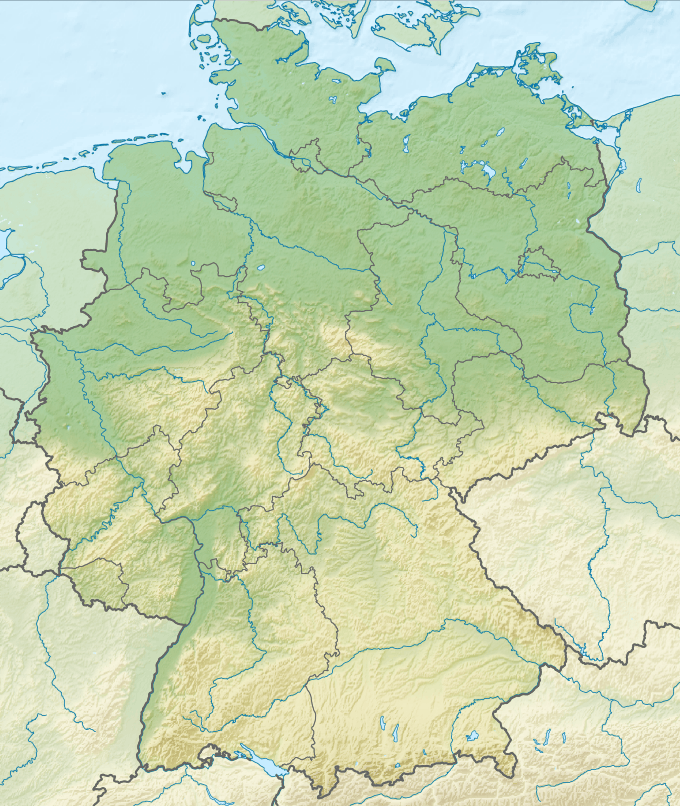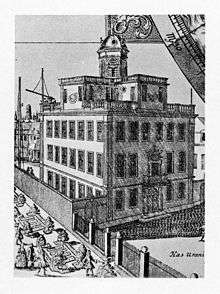Bellevue Palace, Kassel
| Bellevue Palace | |
|---|---|
|
The palace in July 2010 | |
 | |
| Alternative names |
Palais Bellevue, Schloss Bellevue |
| General information | |
| Status | Museum |
| Town or city | Kassel |
| Country | Germany |
| Coordinates | 51°18′35″N 9°29′38″E / 51.309839°N 9.493933°ECoordinates: 51°18′35″N 9°29′38″E / 51.309839°N 9.493933°E |
| Opened | 1714 |
| Design and construction | |
| Architect | Paul du Ry |
Bellevue Palace (German: Palais Bellevue or Schloss Bellevue) in Kassel was built in 1714 for Charles I, Landgrave of Hesse-Kassel. Originally the building served as an Observatory. It became a residence, and then part of Bellevue Castle, which was later destroyed. Today the building houses a museum devoted to the Brothers Grimm.
Location
Bellevue Palace is near the center of Kassel, west of the Fulde River.[1] It is next to the Neue Galerie, an art museum founded in 1976 in an 1874 neo-classical building.[2] Bellevue Palace was erected in 1714 by the French architect and Huguenot refugee Paul du Ry as an observatory for Charles I (1654–1730), Landgrave of Hesse-Kassel.[3]
History
From about 1725 on, the palace was used as a residence for members of the Landgrave's court, such as his mistress Barbara Christine von Bernhold (1690–1756).[4] Prince Frederick II (1720–1785), Landgrave from 1760 on, married Mary, daughter of King George II of England. He had the palace surrounded by an Anglo-Chinese garden, the first such garden on the continent.[5] In 1779, Frederick II opened a public museum of natural history and classical art, the Fridericianum, but kept the royal painting collection in Bellevue palace.[6] In 1790 Simon Louis du Ry renovated the building for William IX (1743–1821).[4]
During the Napoleonic era the palace became the property of Jérôme Bonaparte (1784–1860), King of Westphalia from 1807 to 1813. It first housed his foreign minister, Pierre Alexandre Le Camus.[4] In 1810, Auguste-Henri-Victor Grandjean de Montigny rebuilt the state rooms of the palace,[7] and after Kassel's primary palace had burned in 1811, Jérôme himself moved into Bellevue Palace. Jacob Grimm, the private librarian of King Jérôme and state auditor, was a frequent visitor. After Jérôme was expelled in 1813 William IX, later Elector William I of Hesse (1743–1821), returned. William II (1777–1847) also lived here. The Electress Augusta (1780–1841), who was estranged from William II, used it as her town house and summer residence.[4]
In 1866 Hesse was annexed to Prussia. The building was recovered by a branch of the princely family in 1880.[4] From 1933 until the Second World War it was the residence of Philipp, Landgrave of Hesse (1896–1980), during his tenure as President of the Province of Hesse-Nassau.[8] In the mid-1930s Philipp made parts of the palace into a public art gallery.[9] When Philipp was arrested in September 1943 on suspicion of plotting with the Italian royal family to overthrow Mussolini, the palace was plastered with posters denouncing the Italian royalty.[10] The palace survived Allied bombing raids during World War II (1939-1945) with little damage.[11]
The palace was acquired by the city of Kassel in 1956, and until 1970 it was the home of the Municipal Art Collection.[4] The Louis Spohr museum, closed by the Nazis in 1933, was re-opened in the building in 1967. It included four display rooms and an archive. The displays presented the violinist Louis Spohr and other violinists and violins of the period.[1] In 1972 the Brothers Grimm exhibition was moved to the ground floor of the palace. In 1999 the Brothers Grimm Museum took over the entire building.[4]
The Brothers Grimm exhibition has since moved to a nearby museum, the palace is now closed.
Structure
The Bellevue Palace is the only palace from the early 18th century in Kassel, since the others were destroyed during World War II or in an "anti-feudal" demolition wave in the 1950s.[4] The building has simple but elegant facades, broken only by a slight cornice above the ground floor. It is three stories high and almost square, with two side wings on the rear garden. The street front has a balcony above a classical portal. The building originally had a cross-shaped roof structure with an octagonal dome for the observatory. Later this was replaced by a high mansard roof with gabled extensions.[4] The interior has rooms decorated in a simple combination of rococo style and classicism. The classical stairway is well preserved. The large central room on the ground floor has a beautiful pilaster. Since 1994 the building has been extensively repaired and restored, with an escalator installed.[4]
Gallery
-

The building in 1742, used as an observatory by Johann Gabriel Doppelmayr
-
Baroque door in the courtyard of the palace
-
Fountain in the courtyard
-
Old annex to the palace
References
Citations
- 1 2 Sadie 2005, p. 351.
- ↑ Egert-Romanowskiej & Omilanowska 2010, p. 364.
- ↑ Praeger 1971, p. 1815.
- 1 2 3 4 5 6 7 8 9 10 Das Palais Bellevue: Brüder-Grimm.
- ↑ Lustig 1995, p. 45-46.
- ↑ Paul 2012, p. 286.
- ↑ B de L. 1854, p. 153.
- ↑ Petropoulos 2006, p. 26.
- ↑ Petropoulos 2006, p. 149.
- ↑ Petropoulos 2006, p. 293.
- ↑ Petropoulos 2006, p. 342.
| Wikimedia Commons has media related to Palais Bellevue (Kassel). |
Sources
- B de L. (1854). Biographie universelle (Michaud) ancienne et moderne. Michaud. Retrieved 2014-02-14.
- "Das Palais Bellevue - Sitz des Brüder-Grimm Museums". Brüder-Grimm Museum. Archived from the original on 2013-12-19. Retrieved 2014-02-19.
- Egert-Romanowskiej, Joanna; Omilanowska, Malgorzata (2010-02-15). DK Eyewitness Travel Guide: Germany. DK Publishing. ISBN 978-0-7566-7090-0. Retrieved 2014-02-19.
- Lustig, Irma S. (1995). Boswell: Citizen of the World, Man of Letters. University Press of Kentucky. ISBN 0-8131-3346-7. Retrieved 2014-02-19.
- Paul, Carole (2012-11-16). The First Modern Museums of Art: The Birth of an Institution in 18th- and Early- 19th-Century Europe. Getty Publications. ISBN 978-1-60606-120-6. Retrieved 2014-02-19.
- Petropoulos, Jonathan (2006-05-01). Royals and the Reich: The Princes von Hessen in Nazi Germany. Oxford University Press. ISBN 978-0-19-979607-6. Retrieved 2014-02-19.
- Praeger Encyclopedia of Art. Praeger Publishers. 1971. Retrieved 2014-02-19.
- Sadie, Julie Anne (2005-07-10). Calling on the Composer: A Guide to European Composer Houses and Museums. Yale University Press. ISBN 978-0-300-10750-0. Retrieved 2014-02-19.